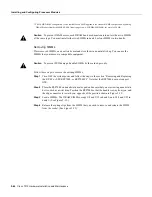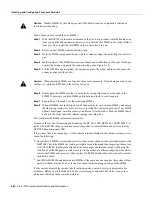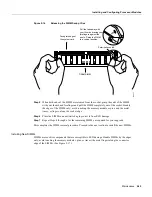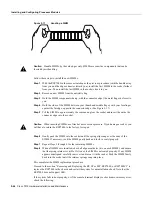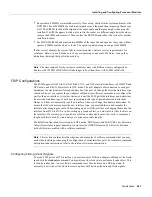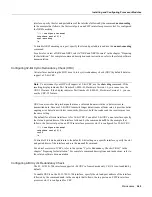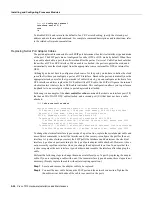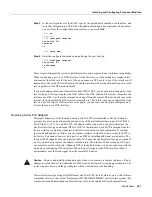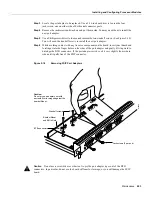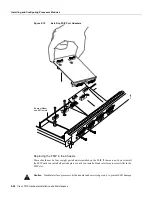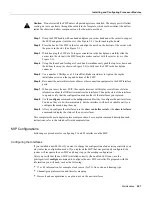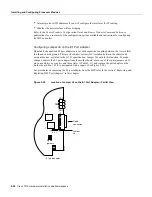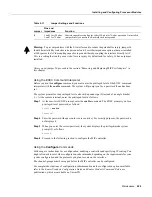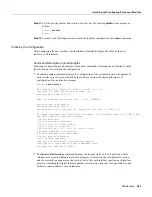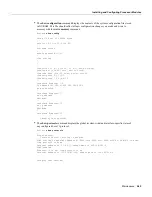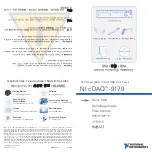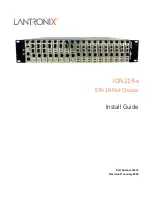
Maintenance 5-51
Installing and Configuring Processor Modules
Step 3
At the privileged level of the EXEC, specify the port address, shutdown the interface, and
write the configuration to NVRAM. Add additional configuration commands, if any, before
you exit from the configuration mode (before you press Ctrl-Z.
7010> en
Password:
7010# configure terminal
int serial 2/5
shutdown
^z
7010# write mem
Step 4
Enter the configuration mode again and bring the port back up.
7010# configure terminal
int serial 2/5
no shutdown
^z
These steps will prompt the system to poll the interface and recognize the new interface immediately.
When configuring a port for a DCE interface for the first time, or when setting up a loopback test,
you must set the clock rate for the port. When you connect a DCE cable to a port, the interface will
remain down, the clock LEDs will remain off, and the interface will not function until you set a clock
rate (regardless of the DCE mode default).
If you are changing the mode of the interface from DCE to DTE, you do not need to change the clock
rate for the port. After you replace the DCE cable with a DTE cable and the system recognizes the
interface as a DTE, it will use the external clock signal from the remote DCE device and ignore the
internal clock signal that the DCE interface normally uses. Therefore, once you configure the clock
rate on a port for either a DCE interface or loopback, you can leave the clock rate configured and
still use that port as a DTE interface.
Replacing Serial Port Adapters
Serial port adapters provide the high-density ports for FSIP serial interfaces. Each port adapter
provides two ports, and each port supports any one of the available interface types: EIA/TIA232,
EIA/TIA449, V.35, X.21, and EIA-530. The adapter cable connected to the port determines the
electrical interface type and mode (DTE or DCE) of the interface. Each FSIP is shipped from the
factory with four or eight port adapters installed. Port adapters are field replaceable; if you have
spares on hand and have a failure, you can replace interfaces without having to return the FSIP to
the factory. You cannot, however, add ports to an FSIP by installing additional port adapters. The
four-port FSIP supports only one 4-port module. To change the electrical interface type or mode of
a port, you need only replace the adapter cable and reset the interface. When setting up DCE port,
you must also set the clock rate. Although DCE is the default mode, you do not need to specify the
mode when configuring DTE interfaces. When the port recognizes the DTE interface cable, it
automatically uses the clock signal from the remote DCE device.
Caution
Remove and install port adapters only when it is necessary to replace interfaces. Do not
attempt to isolate faults or to troubleshoot FSIPs or serial interfaces by swapping port adapters. The
surface-mount circuitry on the port adapters will not tolerate excessive handling.
All serial interface types support NRZI format and 32-bit CRC, both of which you set with software
commands. (Refer to the section “Replacing RSP7000 DRAM SIMMs” earlier in this section.) For
complete command descriptions and instructions, refer to the related software documentation.
Summary of Contents for TelePresence Server 7010
Page 10: ...x Cisco 7010 Hardware Installation and Maintenence ...
Page 14: ...iv Cisco 7010 Hardware Installation and Maintenance Document Conventions ...
Page 148: ...3 36 Cisco 7010 Hardware Installation and Maintenance Using the Flash Memory Card ...
Page 158: ...4 10 Cisco 7010 Hardware Installation and Maintenance Troubleshooting the Processor Subsystem ...
Page 242: ...5 84 Cisco 7010 Hardware Installation and Maintenance Replacing Internal Components ...
Page 258: ...A 16 Cisco 7010 Hardware Installation and Maintenance MIP Interface Cable Pinouts ...
Page 270: ...B 12 Cisco 7010 Hardware Installation and Maintenance Interface Processor LEDs ...
Page 274: ...C 4 Cisco 7000 Hardware Installation and Maintenance ...
Page 287: ...Index 13 ...




